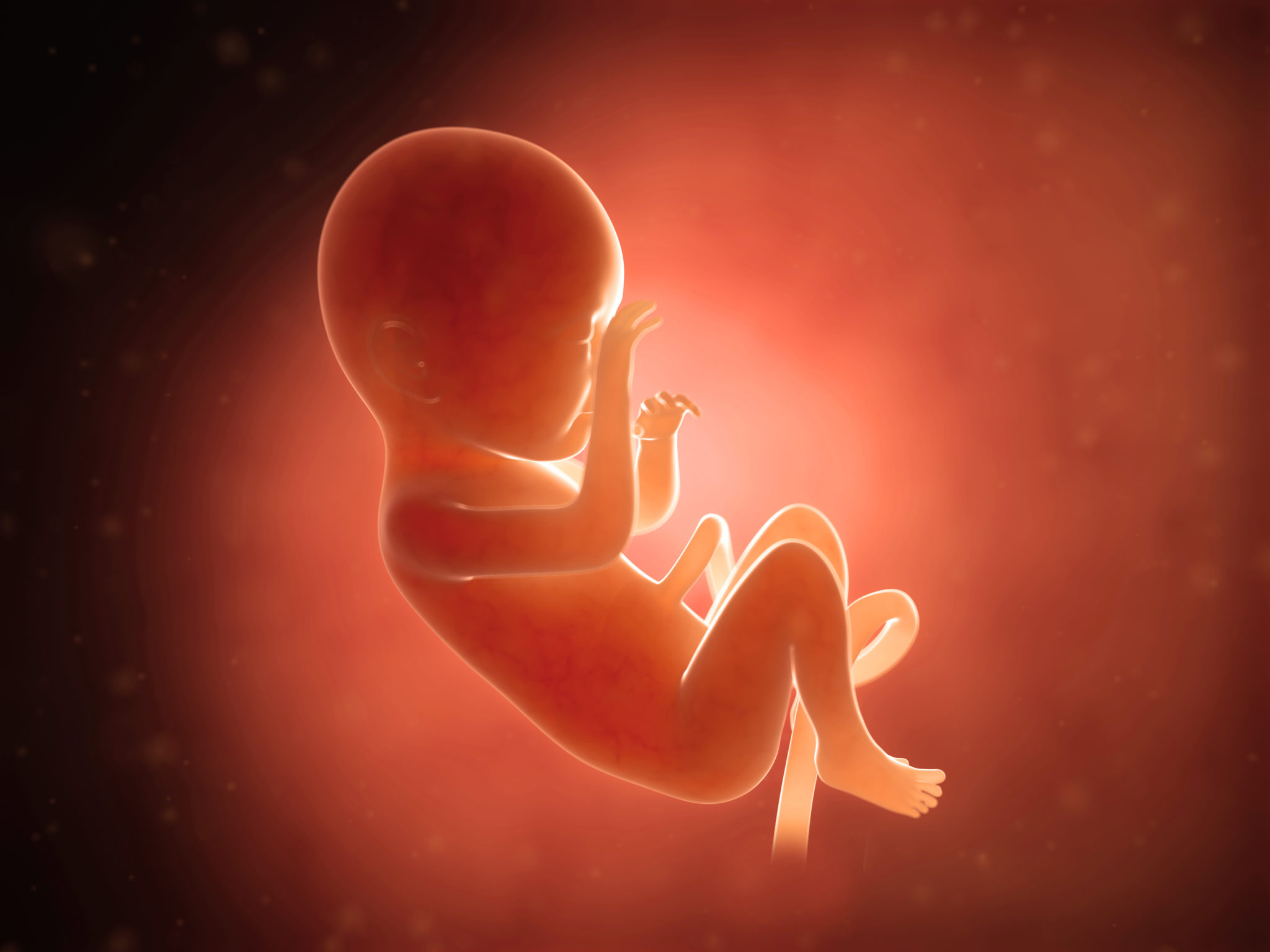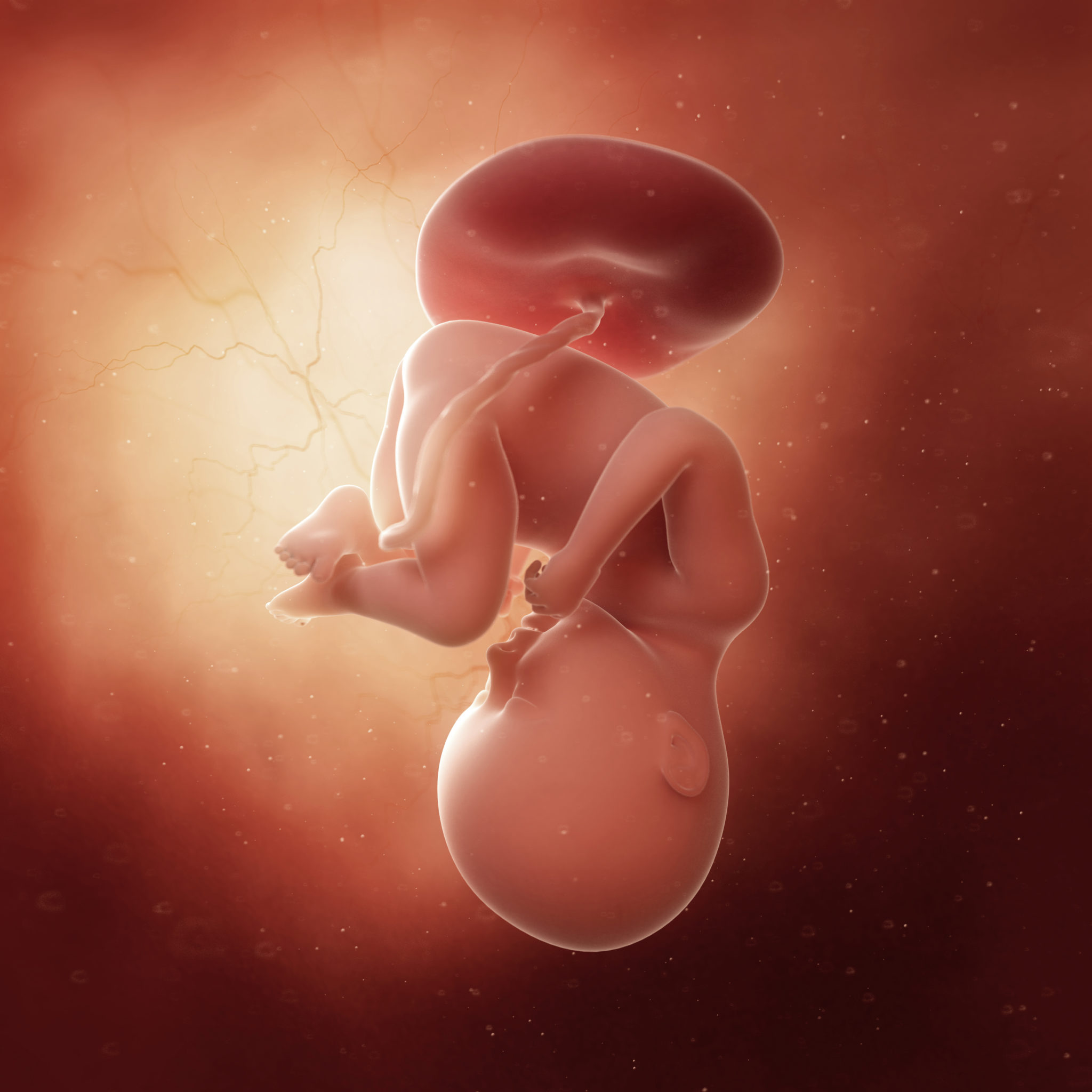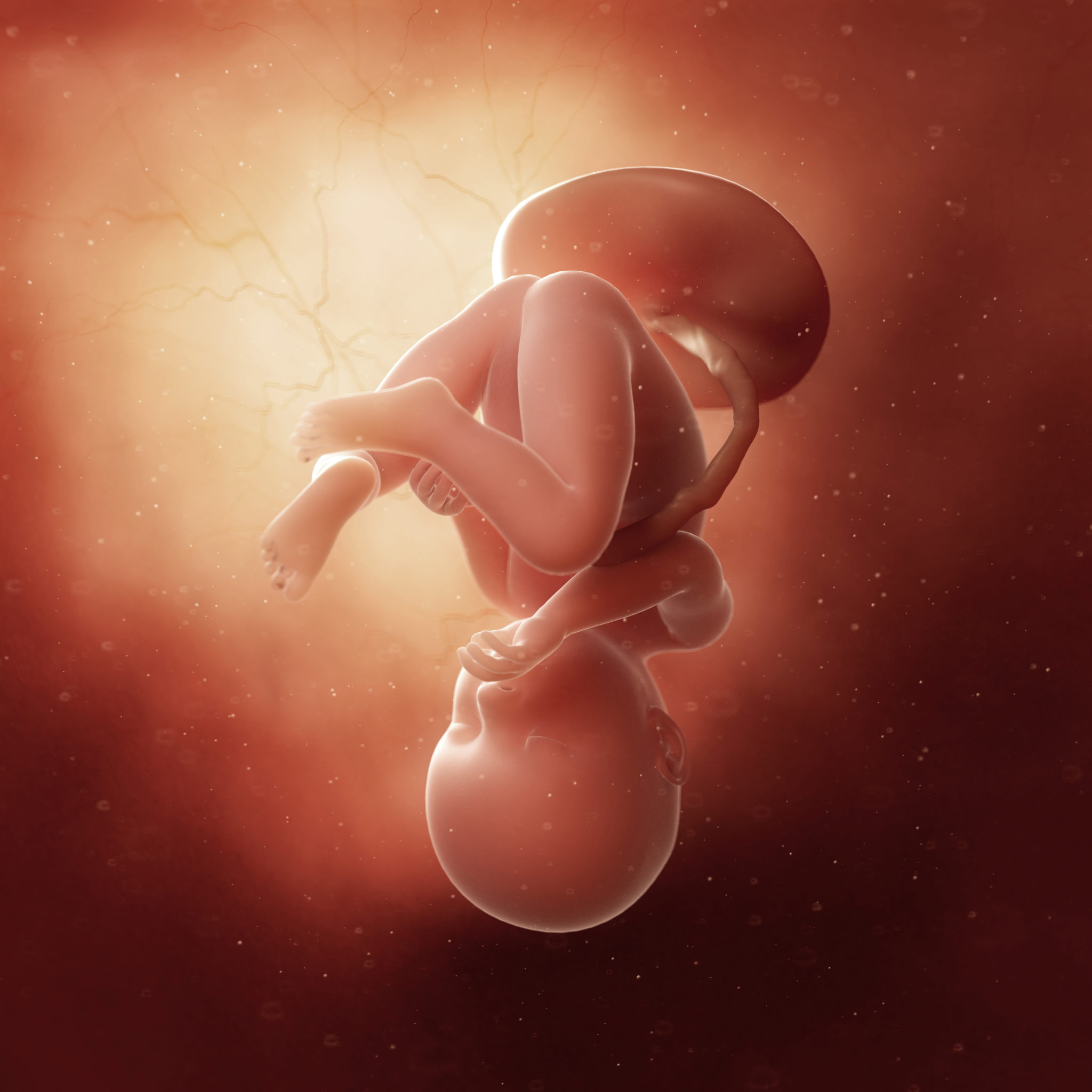Thrive Baby Thrive
Week 28

Welcome to the third and last trimester of your pregnancy. By now you are anxious to meet your little baby. You are twenty-eight weeks into your pregnancy, whereby your baby has a 90 percent chance of being delivered healthy at this time. As every week passes, your baby’s likelihood of enjoying a healthy delivery day is enhanced.
Your little one’s brain continues to mature and increase in size. Your baby’s eyelids, surrounded by eyelashes, are somewhat open. Brief naps from 20–30 minutes will be taken. Wrinkles are decreasing on your baby’s skin as weight is increasing. Your baby is nearly 10 inches long, the length of a long slender cucumber, and weighs nearly 2¼ pounds.
Counting your baby’s movements is vital; three times a day is ideal. Movements should be occurring every hour and should not decrease in number. Movements may or may not become less defined as specific punches and kicks, they can feel more like twirls, twists, jabs and jiggles. Your counts should basically stay the same meaning that your baby is well; a discrepancy in your counts may mean there is a potential problem and that your baby is unwell. Keep in mind that you are looking for anything different from your baby’s usual and normal routine. If a variation is noticed, call your health care team and make a quick trip to L&D to make sure your baby is well. Please be sure to pay close attention to these movements and always trust your instincts.
We believe in tracking your baby’s movements and not relying on hand-held monitors, Dopplers or phone apps to check your baby’s heartbeat.
Week 29

Your baby’s bones have completely matured at this gestational marker, although they remain supple. Your baby is gearing up for an increase surge in growth.
Weighing in at nearly 3 pounds and a little over 10 inches in length, your baby’s actions are now robust, even making you gasp at times! Your baby may be just about 3 inches away from his or her delivery day length but still needs to gain some more weight. By the time delivery day is here, your baby will have at least doubled or nearly tripled this week’s weight.
Week 30

Wow! Thirty weeks have flown by. Your baby’s eyes are now open for a fair amount of the day. A hefty head of hair may be seen as well. His or her brain is continuing to grow and mature; additional furrows and creases are noted on the exterior. This gives your baby’s tiny brain tissue the necessary space to increase as baby matures after birth.
Your baby will perform breathing actions while moving his or her diaphragm steadily. Your tummy may shudder when this takes place.
Week 31

The central nervous system is now developed to the point where your baby’s body temperature is controlled by the brain. Your baby’s brain, body and systems are now working together using all five senses and trillions of brain connections to grow. Little lungs are growing too but are not complete.
Your baby’s sexual development progresses; testicles are descending from the kidneys to the groin to the scrotum in boys. The labia continue developing but will cover the clitoris, which is observable in girls.
As opposed to sleeping, your baby is now enjoying more awake time and activity, which will probably be obvious to you. Your baby is now over 3 pounds and measuring 11 inches from crown to rump.
Week 32

Little toenails can be seen! Your baby is busily working on breathing, sucking and swallowing for delivery day, even though his or her tiny lungs are not yet fully developed. Iron and calcium are just two of the essential minerals your baby is now starting to take in and utilize via the intestinal tract. Since your baby began regulating his or her body temperature last week, insulating silky velvety hair, lanugo, is now beginning to disappear. Your baby’s skin has lost its translucency and is beginning to look more like yours.
Your baby is measuring about 11½ inches long, about the length of a crisp stalk of celery, and weighing about 3¾–4 pounds.
Week 33

At 33 weeks your baby’s eyes are quite remarkable and now focusing. Your baby can detect light as it enters his or her eyes; pupils are dilating and constricting. Over the next four weeks an amazing amount of growth will take place. Tiny lungs are working hard on maturing.
Your amniotic fluid is now at its greatest capacity within the uterus. As little kicks, jabs, twists, punches and twirls continue to be counted and felt, they may be a little more noticeable and forceful. Due to your baby’s rapid growth from now to delivery day and his or her greater size in your uterus, your level of amniotic fluid is not as cushioning.
Your baby may have added an inch in length this week and weighs approximately 4½ pounds. Your baby is the size of a small watermelon.
You may also begin preparing for breastfeeding by reading and researching this exciting topic.
Week 34

Tiny fingernails are complete. The vernix caseosa, the pale whitish layer that shields your baby’s skin has thickened. Your baby is gaining significant weight over the next four weeks. Now at 5½ pounds, possibly adding a half a pound a week, your baby’s is now about 12 inches long and weighs the same as 22 quarter pounders!
Week 35

Sometime between Weeks 32-36, your baby will most likely be in a vertex position, the ideal head-down position in the pelvis ready for delivery day! However, babies may also present in a breech position with your baby’s feet presenting first in the pelvis or a transverse position with your baby lying sideways.
If your baby is not in a vertex position, speak openly with your health care team about this concern. A procedure may be recommended to try and rotate your baby. Do your research and make this decision carefully with your health care team. If you decide to have this procedure performed, make sure that you have the umbilical cord and placenta visualized beforehand.
Your baby’s brain is maturing rapidly. Essential fat is accruing particularly in the shoulder area.
Your baby is putting on a half a pound a week and plumping up little limbs! Now roughly 18 inches long, your baby’s is nearing delivery day length.
Week 36

Now your baby’s skin is now becoming free of wrinkles with no slack. A tiny face is now perfectly circular as little muscles have matured, and sucking will soon be required in providing nourishment upon delivery. Your baby’s skull is supple and pliable and will remain so until delivery; other bones continue to solidify.
Movements may or may not become less defined as specific punches and kicks, they can feel more like twirls, twists and jiggles. However, please be sure to pay close attention to these movements and always trust your instinct. Continue counting movements ideally three times a day. Your baby’s movements should still be occurring every hour and should not decrease in number. Keep in mind that you are looking for anything different from your baby’s usual and normal routine. If a variation is noticed, call your health care team and make a quick trip to L&D to make sure that your baby is well.
Your baby is now tipping the scales at around 6 pounds.
Week 37

Your excitement is building! Your baby is officially deemed full term. All organs are all set to perform on their own. If your baby is not already in the head-down position yet, this could be the week!
Your baby is currently on the homestretch and the once rapid weight gain of the last four weeks is slowing significantly. Your uterus will still allow for a little more growth as baby fat (essential fat) continues to develop. This fat surrounds your baby and will provide warmth once born. An ultrasound at this time may be done to guesstimate baby’s size. To do this, your baby’s head, stomach and femur dimensions will be assessed.
Your baby is now weighing over 6 pounds.
Week 38

Your baby continues to master a strong grasp. Tiny toenails sit at the tops of little toes. Your baby’s brain weighs just under a pound and this growth continues after delivery. The brain is maturing and will aid in perfecting breathing, enhancing digestion, controlling and normalizing heart rate, and getting the baby ready for eating. Your baby’s organs will complete final maturation as nervous system abilities are enhanced; tiny complex systems and functions keep progressing as your baby prepares for birth. Lanugo is barely present on the skin.
Your baby could possibly weigh about 6½ pounds and reaching the final birth length.
Week 39

Your baby’s chest is becoming increasingly dominant. The testes continue descending into the scrotum for boys. The placenta is hard at work furnishing your baby with antibodies that will assist him or her in combating infections following delivery.
Your baby’s movements and heart rate will now basically be staying the same up to delivery day! Movements may or may not have become less defined and you may now be feeling punches, kicks, twirls, twists, jabs and jiggles. Continue counting your baby’s movements ideally three times a day. Remember, a change in your baby’s movements such as speeding up or slowing down, or changes in sleep-wake cycles could be the sign that your baby is not well. Call your doctor, midwife, or health care team with any questions or concerns. If you are unable to reach them go to L&D or the nearest ER to check on your baby. Always trust your instincts.
Week 40-42

Hooray! You are now completing your fortieth and final week of your third trimester. You and your baby have impressively reached the expected due date calculated at your first office visit in Week 8. Your baby may measure approximately 18-20 inches in length and weigh somewhere between 6-9 pounds. Don’t forget, healthy babies range from short to long in length and lean to chubby in weight. All shapes and sizes are nestled in the category, miraculous, when born safely alive and kicking!
Baby’s Not Here
If your baby has not arrived on time, please don’t be surprised or upset. Many moms have babies past Week 40; this is a crucial time during pregnancy as the amniotic fluid surrounding your baby is beginning to decrease and the placental function needed to sustain your baby’s life may be beginning to slow. You will need to discuss with your health care team the probability of when to expect your baby’s arrival or the possibility of planning your baby’s delivery day.
Ask, specifically, how long beyond your expected due date you will be allowed to wait if labor does not begin spontaneously? What additional monitoring will be implemented? Will special tests such as NSTs’ be performed on a daily basis? Will you have weekly or more frequent BPPs’? Is an induction necessary and if so, when? What exactly is involved in an induction? What about scheduling a C-Section? What is your health care team’s overall plan? What is their protocol?
Sometimes the birth plan doesn’t go exactly as planned or even desired. If your plan becomes altered, you should be educated and familiar with your options ahead of time. This will help ensure that you are comfortable making the very best decisions for you and your baby with your team.
A healthy outcome for you and your baby is paramount after the 40-week gestational marker has elapsed. Pay extremely close attention to any changes in your or your baby’s health; this is key. Contact your health care team at any time with any questions or concerns you have until your baby is safely in your arms. Don’t forget to do your movement counting three times a day!
A proactive, vigilant mom will feel empowered to ask the simple, yet important questions that can make a difference in her baby’s health. Operation Due Date empowers expectant moms by educating them about healthy pregnancies, fostering an awareness of their babies daily fetal movements, and the action they can take to help ensure their babies come into the world safe and healthy.
